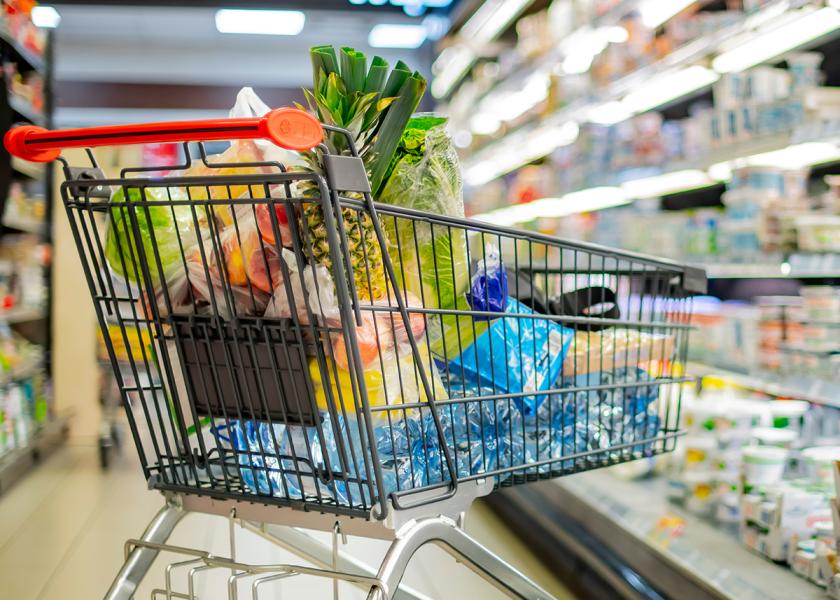U.S. digital grocery sales fell 1% in 2023, survey finds

The U.S. online grocery market finished 2023 with $95.8 billion in total sales, down 1.2% compared to 2022, according to the annualized results from the monthly Brick Meets Click and Mercatus Grocery Shopper Survey. A decline in order frequency by online grocery shoppers was the primary factor driving the lower sales in 2023, according to a news release.
“These annual results show that 2023 was very challenging for grocery retailing as higher prices chipped away at household purchasing power even though inflation has slowed considerably since its peak in 2022,” David Bishop, partner at Brick Meets Click, said in the release. “Despite the challenges, pickup continues to prove its appeal to shoppers, even without the benefits of expanded availability and aggressive promotions that aided delivery in 2023.”
Order frequency among monthly active users, or MAUs, contracted for the second year in a row in 2023. The average number of monthly online grocery orders completed fell 6% versus 2022 following a 4% decline in the previous year. Contributing to the year-over-year contraction was an increase in the share of MAUs who made only one eGrocery order per month, which rose over 300 basis points to 34% in 2023.
Average order value, not adjusted for price inflation, rose 3% in aggregate in 2023 versus the prior year. Each receiving method posted year-over-year increases: delivery AOV grew by 3%, pickup increased by 2.6% and ship-to-home rose 1.7% over 2022.
The overall MAU base, which includes all three receiving methods, climbed 2% compared to the previous year. However, there was a 172-bps increase in the share of MAUs who used one method exclusively, pickup, delivery or ship-to-home, to receive their online grocery order and 70% of MAUs fell into this single-method user category in 2023.
In terms of sales performance, the largest of the three segments, pickup, finished the year relatively steady versus 2022, growing its share of eGrocery sales by 56 basis points to 46% in 2023. Delivery, despite expanded availability due to increased competition among third-party marketplace providers, experienced a sales dip of 0.9% in 2023 versus the prior year but gained an additional 11 basis points of sales share ending the year with 37%. Ship-to-home continued its annual contraction as sales slipped 4.9% on a year-over-year basis, leading to a 66 basis points drop in sales share to 17%.
Across the U.S. eGrocery market, price-value formats like mass and hard discount experienced strong expansion in their respective MAU bases during 2023, in contrast, the supermarket format experienced a contraction. The average number of MAUs increased by 15% for mass and 12% for hard discount versus 2022, while the supermarket MAU base shrank by 4%. On average, 50% of MAUs engaged with mass in 2023, up 559 basis points compared with 2022, 5% of MAUs engaged with hard discount, up 42 basis points and 32% of MAUs engaged with supermarkets, down 194 basis points.
Due to these shifts in buying behaviors, mass expanded its share of overall eGrocery sales by 460 basis points in 2023 to 45% versus the prior year driven by the strong growth in its MAU base. Meanwhile, the supermarket format’s sales share contracted by 390 basis points to 29% due to declines in both its MAU base and order frequency.
Cross-shopping rates between grocery and mass formats continued to increase in 2023. The percentage of households who bought groceries online from both grocery, supermarket plus hard discount and mass during the same monthly period rose 150 basis points versus 2022. As a result, 30% of the grocery MAU base also shopped for groceries online with a mass retailer’s service during the same month in 2023.
The composite repeat intent rate for pickup and delivery services associated with grocery and mass formats slipped by 63 basis points to finish at 61% in 2023, and that downturn was due solely to declining repeat intent for grocery services, not mass. The share of MAUs who were extremely or very likely to use the same service again within the next 30 days climbed 48 basis points to 66% for mass while it fell 311 basis points to 54% for grocery.
"As Walmart grabs market share through its price leadership and omnichannel strategies, regional grocers find themselves in a precarious position. To remain competitive, they must intensify their efforts in improving customer engagement, offering tailored personalization, and building loyalty,” Mark Fairhurst, global chief growth officer for Mercatus, said in the release. “This strategic shift is not just about weathering the storm of price inflation and intense competition, but about thriving in it. By providing a shopping experience that is both seamless and highly personalized, grocery retailers can retain their existing customer base and gradually attract a wider audience."
In terms of share of wallet, online’s share of total grocery spending in 2023 pulled back by 18 basis points versus the prior year to 12.5% based on the last week of spending in each month of the year across all retail formats. Excluding ship-to-home, as most supermarkets don’t offer this service, the combined pickup and delivery segments fared slightly better, falling just 6 basis points compared to 2022 and finishing the year with a 10.4% share of total grocery spending.
More information about December 2023 results is available at the Brick Meets Click eGrocery Dashboard or the Monthly State of the eGrocery Market Report page.







